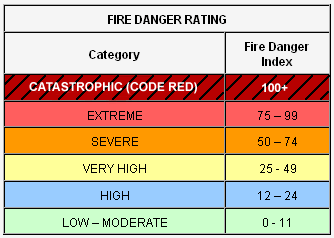What is Fire Danger Index?
By the 1960’s, Alan McArthur had developed a Fire Danger Index (FDI) based on difficulty to control a small test forest fire. A rating of 1 meant easy to control, whereas 100 meant control is virtually impossible. Over the years, FDI has come to be understood and accepted as a measure of bushfire danger. In fact McArthur’s worst ever day, FDI 100, was based on Black Friday in Victoria in January 1939. His figure of 100 was intended to be approximate. He knew his weather data range calculated up to almost FDI 120. 
The Bureau of Meteorology (BOM) forecasts maximum temperature, minimum relative humidity and maximum wind speed and then calculates Fire Danger Index (typically based on forest fire danger indices), which then allows them to assign a Fire Danger Rating. The ranges on the diagram are approximate.
What are TOTAL FIRE BAN days?
Fire agencies tend to declare a TOTAL FIRE BAN when the FDI forecast is around 50.
Prior to 2009, the 50 – 100 range was called EXTREME. Since then, EXTREME has been subdivided into SEVERE and EXTREME. Some weather conditions calculate to greater than 100. These forecast days are now called CATASTROPHIC or CODE RED.
This means TOTAL FIRE BAN DAYS now include Severe, Extreme or Catastrophic levels.
What does this mean to you on your property?
If we take 40*C and 10% RH as a very hot dry summer day, fluctuations in average wind speed (not gusts) are the main cause of Fire Danger Index (FDI) changes. An average wind speed of 20 kph (measured at 10m height in the open) hits FDI 55, a 35 kph wind speed hits FDI 75 and a 50 kph wind hits FDI 100. These wind speed fluctuations typically occur throughout a windy summer day.
What is the influence on the fire front of a change from SEVERE to CODE RED?
Slight influence on flame height in a given fuel bed. Double wind speed tends to double fire speed. Because, flame height is what matters for property defence, there will be minor difference on your property.
What is the influence on ember generation of a change from SEVERE to CODE RED?
A long unburnt patch of forest will generate many more embers and tend to throw them a bit further. Thus, there may be an increase in ember shower volume on your property.
Are these fluctuations significant to the SELF DEFENCE SYSTEM property?
Even if ember fall rate doubles or quadruples, they fall on managed parts of the property and the maximum flame height is already known. Eg, If they fall on LOW FLAME zones, maximum flame height will be as predicted. If they fall onto non flammable surfaces, they will all extinguish. Therefore, there is no significant extra threat to your property.
